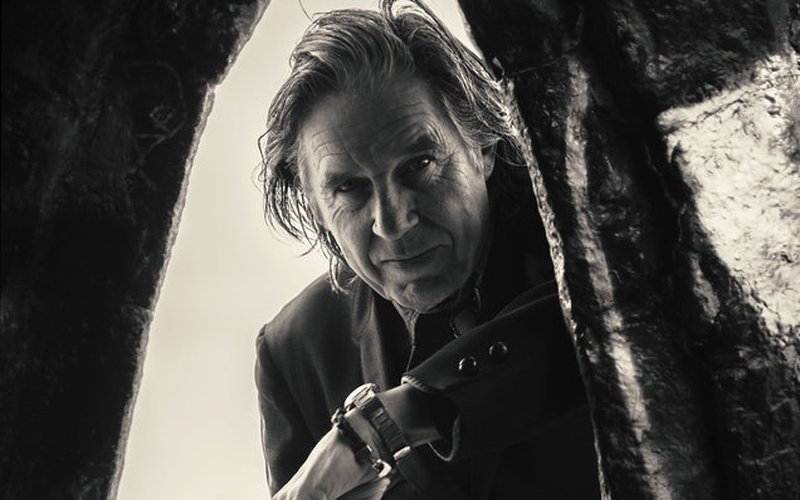
This Wednesday, John Doe of legendary L.A. punk band X will be stopping by Elliott Bay Book Company in support of his latest book More Fun in the New World: The Unmaking and Legacy of L.A. Punk, co-written by Tom DeSavia and released via DaCapo Press,
A follow-up to 2016's Under the Big Black Sun: A Personal History of L.A. Punk, the new book picks up where that one left off: 1982-87, which saw the scene starting to get national attention. An oral history of triumph and tragedy, More Fun in the New World... features essays from Doe and DeSavia, and many more that he lists below.
In advance of the event, KEXP Morning Show producer Owen Murphy spoke to Doe over the phone about the roster of contributors, what made L.A. more fun than other scenes, and the legacy that lives on even though many of these bands have since broken up. Hear more from the interview this Saturday morning on Sound & Vision, but check out these excerpts in the meantime.
The friends are almost too many to mention but I'll give it a shot: Allison Anders, indie film director; Terry Graham from The Bags and The Gun Club, Annette Zilinskas is from The Bangles and Blood on the Saddle; Tony Hawk, the famous skateboarder; Chip Kinman from Rank and File and The Dils; Peter Case from The Nerves and The Plimsouls; Sid Griffin from the Long Ryders; Maria McKee from Lone Justice; Shepard Fairey, one of the most influential artists alive today; Chris Morris; Louis Perez from Los Lobos; Pleasant Gehman from the Screamin' Sirens; Jack Grisham; Charlotte Caffey from The Go-Go's; Keith Morris from Black Flag and Circle Jerks and OFF!; Mike Ness from Social Distortion; W T. Morgan, who's a filmmaker as well; Tim Robbins, the famous actor; Dave Alvin from The Blasters; Jane Wiedlin from The Go-Go's; Angelo Moore and Norwood Fisher, both from Fishbone; Billy Zoom from X; Henry Rollins; and Tom DeSavia and they all write chapters in this book which deals with L.A. music derived from punk rock from 1982 to 1987. And it was a wild journey and it deals with the legacy and how it all blew apart in in the early to mid '80s.
We had cars. And our drug of choice was beer. [ laughs ] I think in New York it sort of came out of the Velvet Underground and an art movement even though the Ramones were sort of anti-art, you know, minimalists in a caveman sort-of way. And then the London scene came out of disaffected youth being on the dole and and a kind of lower class, you know, just shut out of it. It was kind-of political in a lot of ways. And in Los Angeles, it was cheap to live. And so people were doing it like a hedonistic bohemian lifestyle. It's like, I can just get by with $75 a month rent, but still, the streets are dark and and it's film noir. You can be a crazy bohemian and just live for art.
You may not know Lone Justice or Rank and File or Green on Red but you certainly know who Neko Case and The Avett Brothers and Wilco are. And if it wasn't for the L.A. — what was unfortunately called "cow-punk" which sounds to me like "cow-pie" — if it wasn't for that, there wouldn't be any Bloodshot Records. They even did a tribute to The Knitters record which was a tribute to, like, old country music. And if it wasn't for Fishbone and the The Untouchables and some other ska bands in L.A., I think the [Red Hot] Chili Peppers would have had a harder time and sort of No Doubt. And people might not know who the Circle Jerks or Flipper or some other California punk hardcore bands but everybody can sing Green Day and Rancid songs. So there is this lineage and there is this legacy and it also spills out into other art forms. That's why Tim Robbins writes a chapter in this book, Allison Anders, and Shepard Fairey because they took that punk rock ethos and they applied it to a different art form.
Sound & Vision airs Saturday mornings at 7 AM PST. Hosted by Emily Fox and John Richards, the show "uses interviews, artistry, commentary, insight, and conversation to that tell broader stories through music, and illustrate why music and art matter."
For the past 40 years, John Doe has done it all, from fronting legendary punk band X to acting in TV and film. On his twelfth solo album, The Westerner, he found inspiration in the desert around him in Tucson, Arizona, where he was recording with Howe Gelb of Giant Sand. Take a musical journey thro…
Well, now I'm depressed. I just did some math, and it turns out that in 1990, when John Doe took a break after having released six albums as a member of the legendary punk rock band X (see here for #6) and released his first solo album - as practically an elder statesman of punk rock - he was 3 yea…